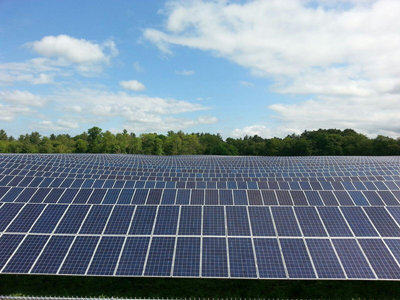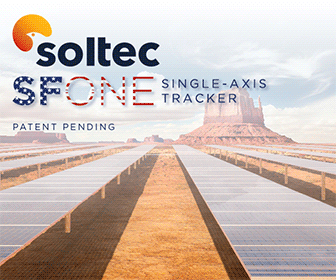Solar Power Projects: Racking design considerations
 Nearly every solar energy project requires some sort of racking solution to mount the solar panels. From roof- and ground-mount projects (including fixed or tracker applications), to carports and covered parking or specialty structures, there are some basic racking design considerations that apply to every solar project.
Nearly every solar energy project requires some sort of racking solution to mount the solar panels. From roof- and ground-mount projects (including fixed or tracker applications), to carports and covered parking or specialty structures, there are some basic racking design considerations that apply to every solar project.
The basics
Once a location has been selected for a solar power project, additional decisions should be made on the following important features…
- Shading considerations. Solar modules need the sun to do their job, so it’s important to take account of any surrounding obstructions that might shade or interfere with the efficiency of energy production.
- Azimuth and tilt. Installations should be oriented in such a way as to optimize production—in the United States, solar modules are generally pointed south; the tilt will vary based on the project location’s latitude or other production analysis.
- Racking type. Whether roof-mount or ground-mount, fixed-tilt or a tracking system, any one or a combination of racking solutions are available and must be considered depending on the project.
Design details
Once the exact siting has been determined for solar modules in a project, it’s essential to narrow down to the details of the design. There are many potential options to consider, so herein we’ll focus on higher-level design considerations.
Each type of racking solution requires specific information, but generally, when looking for an ideal solar solution, consider the following:
- Applicability. This may seem obvious, but not all solar products or designs will fit all projects. For example, a covered parking solution for a standard, ground-level parking lot might seem like a good fit, but might not be the best solution available for the top deck of a parking garage. It’s important to know what you’re investing in and to understand what racking solution provides the best fit for your particular project.
-
Manufacturing. Know your manufacturer. Some suppliers specialize in one type of racking solution more than another, offering product-specific expertise. Other companies might provide more flexibility by offering a wider selection of design services and racking solutions. There can be advantages and disadvantages to both of these approaches.
Weighing the experience and the services offered by a racking manufacturer can be significant when it comes to selecting the best solution for your solar project. Consider the following when choosing a racking manufacturer…
- Quality and range of products (also consider the company and product history);
- Design services offered (for instance, are engineering solutions provided; and what about any drawings that might be needed for permitting approvals?)
- Training and installation services (what does the project scope require, and what type of project management is offered, if at all?)
- Warranty (if something goes awry with the racking structure, what is covered, under what circumstances, and for what length of time?)
- Lead times (are the materials ready to go, or what’s the timeframe and will it meet the project deadline?)
Racking types
The type and variety of solar racking solutions available are numerous, and the best choice will depend on the project type, the location, and overall product quality. Here’s a breakdown of the more common solutions offered and what to consider with each:
Roof-mount
An increasing number of PV systems are being installed in residential and commercial applications across the US. Although many of the available roof areas, particularly at commercial sites, are considered flat, even flat roofs tend to have a minimal slope to them. And, many residential roofs differ in terms of composition (i.e. shingles, curved tiles, Spanish tile, flat concrete tile, etc.).
It’s therefore, imperative to evaluate the following:
- Roof type. Consider the structure and shape, as well as its roofing material (is it flat or sloped; can it support a solar racking installation?);
- Any obstacles. Boundary and clearance issues all must be taken into account (such as shading or accessibility restrictions); and
- All attachments. Some racking systems penetrate the roof and require mechanical racking attachment; others are purely ballasted, roof-mount applications. What type works for your project?
Ground-mount
Often used for larger solar project, as well as at utility-scale sites, ground-mounted systems come in fixed-tilt and tracker options. Fixed means the panels stay in one stationary position. A solar panel mount that allows the panel to move with the sun is called a tracker. When choosing a ground-mount system, consider:
- Site topography. Topography can significantly affect the design of the racking structure, and versatile racking designs can mitigate and limit the amount of site work that may be required.
- Underground conditions. Beyond just the topography, soil properties affect the very foundation of the project design (does the site have landfill/brownfield limitations where the ground cannot be penetrated; are there utilities nearby?)
- Ground-cover ratio. Although not necessarily specific to the design of a racking system, it’s important to consider tilt, row spacing, and shading for optimizing the production of a ground-mounted array.
- The tracking. A tracking system can be single-axis or dual-axis, depending on the type of control systems that are in place. Single-axis trackers have a single degree of flexibility in terms of rotation, whereas dual-axis allow for two degrees of flexibility, offering a much wider range of motion. There are pros and cons to each, depending on the project.
- Operations and maintenance. Prior to the project, consider the O&M costs and requirements, which tend to be most applicable to projects with trackers.
Carports & canopies
Solar carports, canopies, and structures put to good use large areas of open space, generating electricity, while providing shade for cars or storage and more. When designing such structures, it’s important to:
- Make do. Generally, it’s best to make use of existing layouts, rather than redesigning what is (such as an entire parking lot, for example);
- Meet the minimum. Ensure proper height clearances are considered, especially for vehicles;
- Consider the columns. In a parking structure, some design layouts require that columns fall within certain parking spaces, but it may be desired to find a solar solution that doesn’t affect the number of usable parking spaces; and
- Find the foundation. Underground conditions can vary, and are an important feature to consider in larger structures, as often times there are existing utilities to consider.
Final thoughts
As can be seen, a lot goes into the design of a solar power project. Selecting the site and the modules are just the beginning. Picking the most applicable and effective solar racking solution is often key to a successful installation.
In addition, any design must be up to code standards. This applies to the structural and electrical design, including: wind loads; snow loads; seismic design; electrical bonding and grounding of the modules (and the racking solution); wire management; and more depending on the state regulations. There are many considerations that developers must pay attention to when choosing the best racking solution for a potential solar power project.
Mike Slack has more than 11 years work experience as a structural engineer, and is a registered professional engineer that’s licensed in 48 states. He is a member of the American Society of Civil Engineers and the American Institute of Steel Construction, and is the director of engineering for RBI Solar.
RBI Solar designs, engineers, manufactures, and installs solar mounting systems for commercial and utility-scale solar projects. Learn more at www.rbisolar.com/solutions/ground-mount-solar
RBI Solar, Inc.
www.rbisolar.com
Author: Mike Slack
Volume: July/August 2014










.jpg?r=8688)
.gif?r=8774)
.jpg?r=9880)